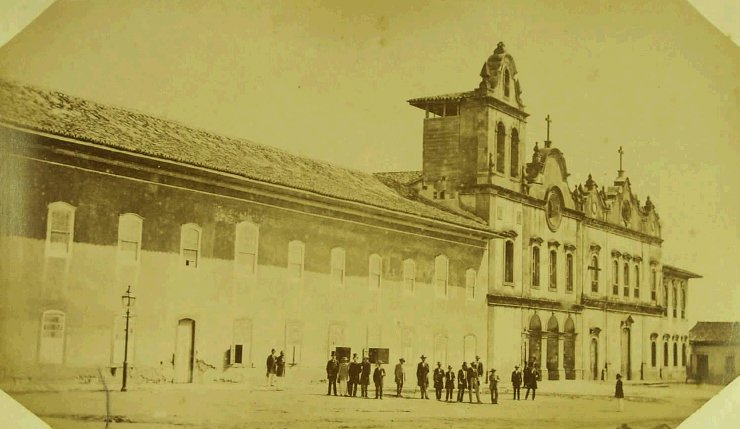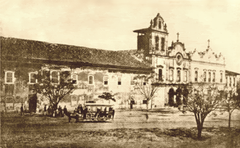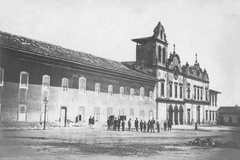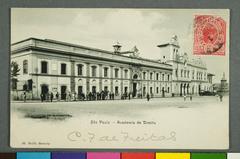
San Francisco Convent and Church São Paulo: Comprehensive Visiting Guide, History, and Tips
Date: 14/06/2025
Introduction
Nestled in the historic heart of São Paulo, the San Francisco Convent and Church (Igreja e Convento de São Francisco) stand as enduring symbols of Brazil’s colonial heritage and Franciscan spirituality. Established in the early 17th century by Franciscan friars, this architectural complex has played a pivotal role in São Paulo’s religious, cultural, and educational evolution. Today, it is not just a monument to the city’s past, but also a living destination for worship, academic endeavor, and tourism.
This guide provides everything you need to know for a memorable visit: detailed historical background, architectural highlights, practical visitor information (hours, ticketing, accessibility), recommended nearby attractions, and essential travel tips. Whether you’re captivated by Baroque art, colonial history, or São Paulo’s vibrant urban fabric, the San Francisco Convent and Church invite exploration and reflection. For deeper insights, see Wikipedia’s Largo de São Francisco, São Paulo Secreto, and Machupicchu Terra.
Table of Contents
- Early History and Foundation
- Architectural Evolution and Baroque Legacy
- Urban Development and Educational Role
- Religious and Cultural Significance
- Visitor Information
- Nearby Attractions
- Tips for Visitors
- Frequently Asked Questions (FAQ)
- Conclusion
- References
Early History and Foundation
The story of the San Francisco Convent and Church begins in 1639, when seven Franciscan friars journeyed from Rio de Janeiro to São Paulo, seeking to establish a new religious community. Their first site, near present-day Patriarca Square, proved inadequate due to water scarcity and harsh winds. The city council soon donated a more suitable plot, enabling construction to begin. The convent was inaugurated on September 17, 1647, coinciding with the Feast of the Wounds of Saint Francis, and quickly became a spiritual and social cornerstone in colonial São Paulo (Wikipedia: Largo de São Francisco).
Architectural Evolution and Baroque Legacy
Exterior and Façade
The convent and church are exemplary of colonial Baroque architecture, with thick rammed earth walls (up to 1.5 meters), a restrained but harmonious façade, and a single bell tower—a Franciscan signature. The main entrance features Franciscan emblems like the crossed arms of Christ and St. Francis, surrounded by floral and geometric motifs that invite contemplation (Machupicchu Terra).
Interior and Artistic Highlights
Inside, the church reveals:
- Baroque Gilt Woodwork (Talha Dourada): Lavish carved and gilded woodwork covers altars, pillars, and ceilings, creating a dazzling, sacred atmosphere.
- Azulejo Tile Panels: Blue-and-white ceramic tiles, imported from Portugal, depict Franciscan and biblical scenes, blending beauty with didactic storytelling.
- Spatial Organization: The nave is divided into three aisles by robust columns—unusual for Franciscan churches in Brazil—flanked by lateral chapels dedicated to saints.
- Altars and Choir: The main altar is richly adorned, and the rosewood choir stalls are masterpieces of colonial craftsmanship. A monumental choral book and large canvases further reflect the friars’ devotional and artistic pursuits.
Cloisters and Monastic Life
The attached convent is organized around tranquil cloisters with stone columns and gardens, offering spaces for meditation and community. These cloisters embody both practical shelter and symbolic reflection on paradise and communal life (Wikipedia: Church and Convent of São Francisco, Salvador).
Urban Development and Educational Role
By the mid-17th century, the convent and church shaped the surrounding urban landscape, with the area in front known as Largo do Capim (due to abundant grass). In 1828, the former convent became home to the Law School of the University of São Paulo (Faculdade de Direito da USP), cementing its role as an intellectual beacon. The area, now Largo de São Francisco, remains synonymous with legal scholarship and Franciscan heritage (Wikipedia: Largo de São Francisco).
Religious and Cultural Significance
The San Francisco Convent and Church have long been spiritual and cultural hubs, serving both the Franciscan order and the wider Catholic community. Their influence extends to supporting social justice, education, and charitable works. The complex also features the Church of the Third Order of Penance, creating a rich ensemble of religious architecture.
The site is a living monument, hosting regular Masses, festivals, concerts, and outreach programs, and remains a vibrant center for faith and culture (São Paulo Secreto).
Visitor Information
Hours
- General: Tuesday to Sunday, 9:00 AM – 5:00 PM
- Closed: Mondays and public holidays
- Note: Hours may vary during religious events; check ahead for updates (São Paulo Secreto).
Tickets
- Admission: Free for general entry
- Guided Tours: Some special exhibitions or tours may require a modest fee; book onsite or via official tourism sources.
Accessibility
- Wheelchair Access: Partial; ramps and elevators are available in some areas, but original architecture may limit access in others. Contact the administration in advance if you need assistance.
Guided Tours
- Languages: Portuguese and English
- Booking: Recommended in advance, especially in peak season
- Value: Tours provide historical, artistic, and architectural context, often including restricted areas like the sacristy and choir.
Conduct & Photography
- Photography: Non-flash photography allowed in most areas; flash and tripods generally prohibited.
- Attire: Modest dress recommended
- Behavior: Maintain silence, especially during services; be respectful of worshippers.
Nearby Attractions
The San Francisco Convent and Church are at the heart of São Paulo’s historic center, close to:
- São Paulo Cathedral (Catedral da Sé): Neo-Gothic masterpiece, 10-minute walk (PlanetWare).
- Pátio do Colégio: Birthplace of São Paulo, with museum and church (GoAskALocal).
- Mosteiro de São Bento: Benedictine monastery famed for Gregorian chants and pastries.
- Municipal Theatre: Iconic performance venue.
- Law School of USP: Historic building adjacent to the church.
- Church of the Wounds of the Seraphic Father Saint Francis: Adjacent chapel built by the Secular Franciscan Order (Wikipedia: Church and Convent of Saint Francis (São Paulo)).
- Liberdade District: Japanese-Brazilian quarter, vibrant street market.
- Museum of Sacred Art: Extensive religious art collection (WideWorldTrips).
Tips for Visitors
- Best Time: Weekday mornings or early afternoons to avoid crowds.
- Duration: 30–45 minutes for the church; half a day with nearby attractions.
- Safety: Visit during daylight; the area can be quiet after dark.
- Transport: Metro (Sé and Anhangabaú) and bus lines nearby; parking limited.
- Amenities: Limited restrooms; nearby cafés and public buildings offer facilities.
- Language: Signage mostly in Portuguese; English-speaking guides available via tours.
Frequently Asked Questions (FAQ)
Q: What are the San Francisco Convent and Church visiting hours?
A: Tuesday–Sunday, 9:00 AM–5:00 PM. Closed Mondays and holidays. Hours may vary during events.
Q: Is there an entrance fee?
A: General entry is free; guided tours or special exhibitions may require a small fee.
Q: Are guided tours available?
A: Yes, in Portuguese and English. Advance booking recommended.
Q: Is the site accessible for people with disabilities?
A: Partially accessible; contact ahead for assistance.
Q: Can I take photographs inside?
A: Yes, but without flash; always respect posted restrictions and ongoing services.
Conclusion
The San Francisco Convent and Church is a living testament to São Paulo’s layered history, blending colonial architecture, Franciscan spirituality, and educational tradition. Its richly decorated interiors, tranquil cloisters, and Baroque artistry provide a window into Brazil’s past, while its location in the bustling downtown connects visitors with the pulse of the modern city.
Whether you are a pilgrim, history enthusiast, or casual traveler, your visit promises insight, reflection, and inspiration. For the latest updates on tours, events, and visiting hours, download the Audiala app and follow us on social media. Explore related posts for more on São Paulo’s historical and cultural treasures!
References
- Wikipedia: Largo de São Francisco
- Machupicchu Terra: Church and Convent of São Francisco
- São Paulo Secreto: Historic Churches of São Paulo
- Wikipedia: Church and Convent of Saint Francis (São Paulo)
- PlanetWare: São Paulo City Attractions
- GoAskALocal: Things to Do in São Paulo
- WideWorldTrips: Things to Do in São Paulo
- GetYourGuide: São Paulo Downtown Tour
- Touropia: Tourist Attractions in São Paulo






































































































































































